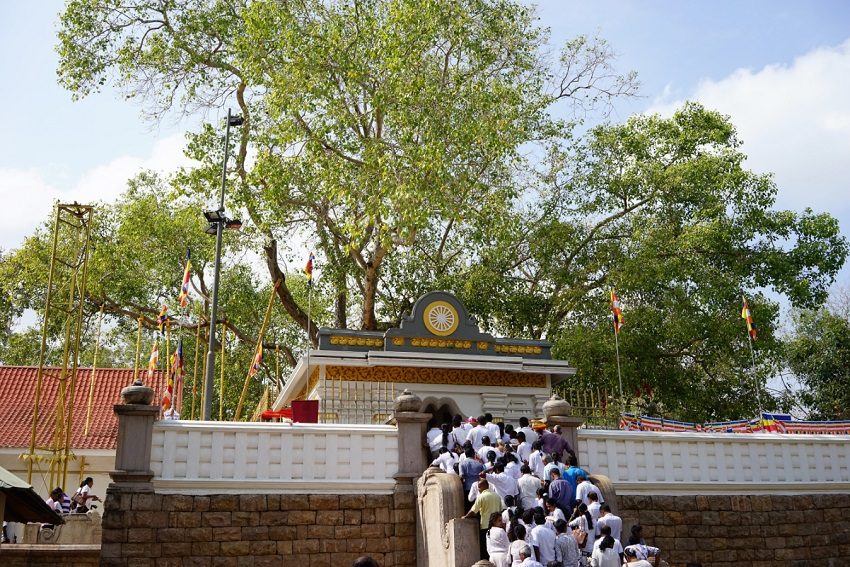Greenspace: The Oldest Historical Tree in the World

“In Sri Lanka, there grows to this day, a tree, the oldest historical tree in the world.” – H.G. Wells
Late last year our family made a pilgrimage to the ancient city of Anuradhapura in Sri Lanka. The World Heritage site illustrates millennia of Sri Lanka’s cultural history while remaining an important contemporary religious and regional centre. Our visit coincided with the Ill Full Moon Poya day public holiday drawing crowds to the Thuparamaya, Sri Lanka’s source for Buddhism, and to the ancient Jaya Sri Maha Bodhi – the oldest cultivated tree in the world with a documented written history.
The veneration accorded this tree, especially by devotees of the Theravada Buddhist tradition, reflects the direct connection of this tree to the living Buddha.
The Jaya Sri Maha Bodhi was established from the southern branch of the peepal (or esathu) tree (Ficus religiosa) in whose shade the Buddha achieved enlightenment. This branch was brought to Sri Lanka from India in 236 BC by the Buddhist nun Sanghamitta Maha Theri, through the patronage of King Ashoka, a convert and powerful supporter of Buddhism – she is often referred to as his daughter, and accordingly, as a princess.

The Jaya Sri Maha Bodhi tree has a direct connection to Buddha’s enlightenment
So, the Jaya Sri Maha Bodhi is around 2250 years old and has been curated and protected by Buddhist monks and devotees throughout its life. Such devotion to a tree deserves some contemplation – certainly the tree is approached with piety for its connection with the Buddha but the tree is singular, and an individual in its own right and the achievement in protecting the tree demonstrates what good people can do.
Buddha’s enlightenment dates from around the 5th century BC and took place near the river Neranjana at Bodh Gaya in the Bihar State in northern India. The peepal tree was already a place of devotion, and after the Buddha’s enlightenment was identified as the Bodhi tree and became a pilgrimage site during his lifetime. Sanghamitta’s arboricultural endeavours turned out to be timely as subsequent arboricidal events show.
King Ashoka’s second wife, Tisayaraksita, jealous of her husband’s love for the Bodhi, had the tree pierced by poisonous mandu thorns, although the tree subsequently regenerated. To protect the Bodhi tree, Ashoka built a three-metre high stone wall (elephants particularly like them). But within half-a-century the tree was destroyed by King Pushyamitra Shunga during his persecution of Buddhism. The tree planted to replace the Bodhi, possibly at that stage a scion from the original, was destroyed at the beginning of the 7th century AD – this time by King Sassanka.
Accordingly there is considerable doubt as to whether the present tree at Bodh Gaya is even a scion of the original. This tree was planted by Alexander Cunningham, a British archaeologist in 1881 after the death of its predecessor. Such doubts over the provenance of the original Bodhi tree at Bodh Gaya see the Jaya Sri Maha Bodhi at Anuradhapura viewed as the closest authentic link to the living Buddha and, consequently, as the preferred for scion wood for establishing the Bodhi trees that are central to many Buddhist temples in Asia.

Worshippers assemble at Bodh Gaya
While the Bodhi tree is important to Buddhists, the tree that the Buddha chose to sit under was already a sacred tree in Hindu doctrine. In the Bhagavad Gita the Lord Krishna declares that, ‘Of all the trees I am the peepal tree’ and the peepal is mentioned as one of the names of Lord Vishnu in the Vishnu Sahasramana. In India sadhus choose them for meditation and many Hindus still practice pradakshina including circumambulation, or meditative pacing around peepal trees with an accompanying chant of ‘vriksha rajaya namah’ (‘salutation to the king of trees’). So while the Buddha chose the peepal tree perhaps the peepal tree might also have chosen the Buddha.
Sacred trees and sacred groves aren’t isolated to Hinduism and Buddhism in human history. The earliest written chronicles including the Epic of Gilgamesh and the Bible record both the destruction and the planting of sacred groves. Hiking in the Simien Mountains of Ethiopia the only stands of trees still remaining are such sacred groves, including the ‘church forests’ associated with Ethiopian Orthodox Tewahedo churches and monasteries. In earlier times such sacred groves were revered by Agao pagans whose religious gatherings, sacrifices and burials were associated with the groves. These groves were apparently also adopted by early Islamic converts.
 A Buddhist shrine with Buddha seated below a peepal tree
A Buddhist shrine with Buddha seated below a peepal tree
While the traditions associated with such groves are disappearing globally alongside the global destruction of forests and the globalisation of culture, the truth in these relationships remains relevant. In a post last November Reuters journalist Dean Yates outlined his experiences following the development of Post Traumatic Stress Disorder as a war correspondent. While professional help has been critical Yates witnesses the solace provided by the ancient trees of the Tasmanian wilderness.
Trees play a critical role in food, water and climate security, but they also play a critical role in our spiritual wellbeing. Our future depends on them.